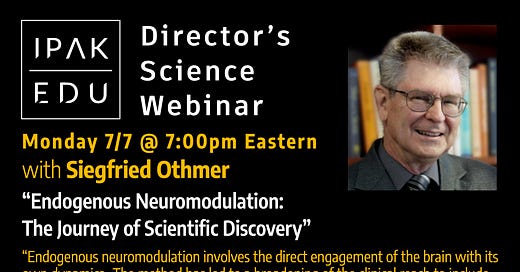IPAK-EDU Director’s Science Webinar
Monday 7/7 @ 7:00pm Eastern
with/ Siegfried Othmer, PhD
“Endogenous Neuromodulation: The Journey of Scientific Discovery”
From Dr. Othmer:
“The migration from Operant Conditioning to Endogenous Neuromodulation took the traditional path of bottom-up, empirically driven hypothesis formation and pruning. It led to a virtual Cambrian Explosion of clinical applications, as we found our way to the foundations of the regulatory hierarchy. This depended on teasing out the rules by which neuroregulation is organized in the spatial and frequency domains. Covering four decades, the development mirrored the evolutionary theory of punctuated equilibrium, with a few critical insights fundamentally altering the landscape along the way.”
Below is a descriptive summary excerpt on infra-low frequency neuromodulation from Frontiers in Human Neuroscience:
Endogenous Neuromodulation in the Infra-Low Frequency Regime
Psychopathology is increasingly recognized as being largely grounded in the dysregulation of neural network dynamics. Such a mechanism should be remediable via neuromodulation techniques. Reinforcement-based neuromodulation has been actively utilized since the sixties. Such techniques have now been complemented with endogenous neuromodulation, characterized by the absence of any reinforcers.
Endogenous neuromodulation involves the direct engagement of the brain with its own dynamics in the EEG and Slow Cortical Potential domains, in the absence of extrinsic rewards or stimulation. Visual, auditory, and tactile feedback is given on the dynamics of selected frequencies that govern the organization of the spectral regime. These ‘optimal response frequencies’ (ORFs) populate the EEG range and extend deeply into the infra-low frequency region. The method has led to a broadening of the clinical reach to include more severely impaired individuals and more complex clinical presentations traceable to early developmental trauma.
Clinical evidence is promising for application to the Anxiety/Depression spectrum, PTSD, Bipolar Disorder, schizophrenia, and Dissociative Identity Disorder in psychiatry, as well as to migraine, epilepsy, traumatic brain injury, and stroke in neurology. Dysautonomia responds to the training, as well as Panic Disorder and Asthmatic episodes.
Endogenous Neuromodulation has largely matured at the hands of scientists/practitioners. Thus, a primary objective is to bring this method to the attention of the research community. The principle of Optimal Response Frequency, with its associated frequency rules, has implications for how cerebral regulation is organized in the frequency domain. Secondly, endogenous neuromodulation offers a solution to the conundrum of how one probes resting states of the brain without overtly interfering with them.
Infra-Low Frequency Neurofeedback presents us with a successful working model of how to approach functional enhancement of a complex self-organizing system: hypothesis-based trial-and-error learning. Every client serves as his or her own control, with A-B comparisons at every choice point. Progress is tracked via Ipsative Trend Analysis on state variables.
The method promises to fill an urgent unmet need in the healthcare field: the remediation of the consequences of physical and emotional trauma, early childhood developmental trauma in particular. It is also applicable to the relatively intractable clinical conditions in psychiatry.
The original research paper authored by Susan and Siegfried Othmer, et. al., presenting the clinical model for Infra-Low Frequency Neuromodulation, which also covers domains of clinical application:
Othmer S., Othmer S.F., Kaiser D.A., Putman J. (2013). Endogenous Neuromodulation at Infra-Low Frequencies. Seminars in Pediatric Neurology, 20(4): 246-260
DOI: 10.1016/j.spen.2013.10.006
The treatise is accessible for free here:
The updated description of the clinical approach:
Othmer, S. (2023). Endogenous Neuromodulation at Infra-Low Frequencies, Chapter 17, Introduction to Quantitative EEG and Neurofeedback, Third Edition, Chartier, DR, Dellinger, MB, Evans, JR, Budzynski, HK, editors, Academic Press, London, pp. 283-299
DOI: https://doi.org/10.1016/B978-0-323-89827-0.00001-2
The treatise is accessible for free here: https://www.researchgate.net/publication/372159982_Endogenous_Neuromodulation_at_Infra-Low_Frequencies
Once a week, this webinar series brings a focus to science as it applies to public issues of concern. The webinar brings to you expertise from scientists, researchers, data analysts, medical professionals, health advocates, attorneys, and more, all with the opportunity to learn, ask questions, and hear directly from people working at the leading edge.
Join us!
If you like what you see, and you’re willing and able, consider leaving a tip. Thank you!
Keep reading with a 7-day free trial
Subscribe to Twisting Strands to keep reading this post and get 7 days of free access to the full post archives.




